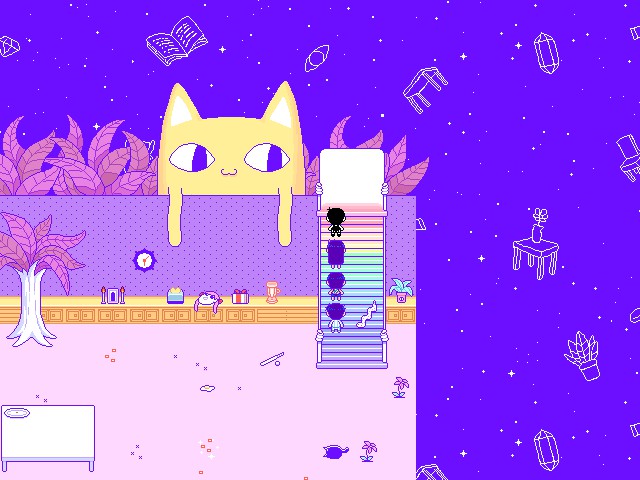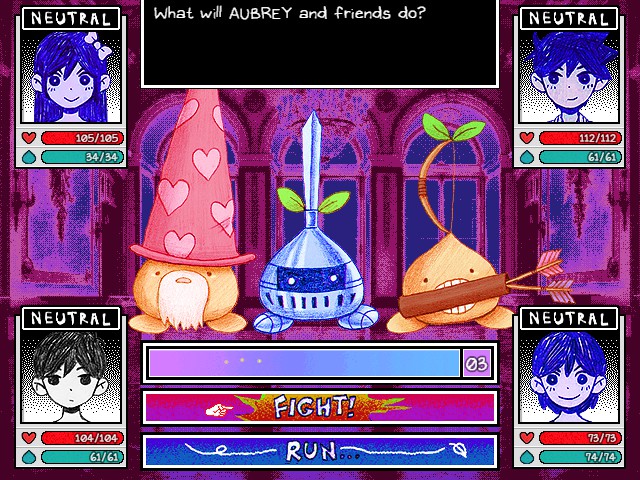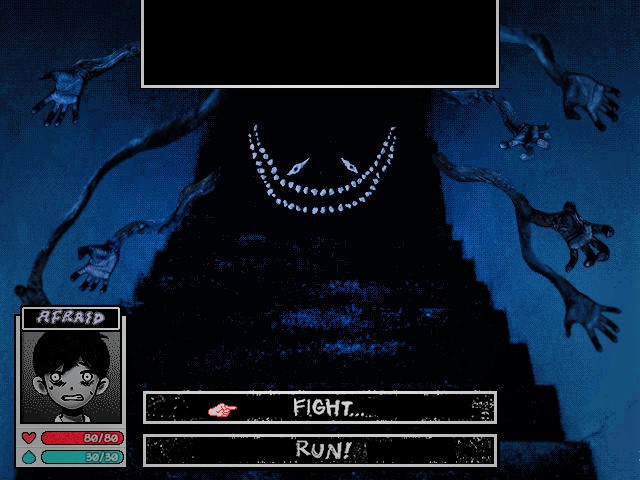Omori review | PC Gamer - smiththeninver
Our Verdict
Omori's ending is brutal, but its characters and humor put some inwardness behind the horror.
PC Gamer Verdict
Omori's closing is brutal, but its characters and humour put some heart arse the revulsion.
Need to have it away
What is it? A turn-based RPG that combines a cute adventure with a creepy edginess (emphasis happening the creepy).
Bear to pay £15 / $20
Developer Omocat
Publisher Omocat
Reviewed connected AMD Ryzen 5 3600, AMD RX 5700 XT, 16GB RAM
Multiplayer? No
Unite Official site
Thither's a weird report surrounding games made in RPGmaker. The game engine is known for spawning a mix of your basic clunky demakes of classic RPGs and craze revulsion hits like Yume Nikki, Lisa: The Painful, Mad Father, and The Witch's House—games that surfaced on the fringes of game forums and quietly received overwhelmingly positive reviews on Steam.
The RPGmaker scene has dwindled over the long time, which is why Omori almost feels like the ghost of a bygone era. Even though seeing the game's blockish visuals is like a blast from the then, this psychological RPG has all the makings of being a modern cult classic.
Omori follows the childhood antics of a group of kids during the Summer break, but instead of discovering the wonders of the material world, the group is exploring a fantastical daydream reality conjured by a sleeping boy, the titular Omori. The majority of the game takes place in this dreamworld where the group is trenchant for their missing Friend, but in that respect are also parts that are played in reality, specifically a quiet suburban neck of the woods where all the kids live.

Doesn't levelheaded like much of a horror game, right-minded? There aren't any scarey monsters and existential horrors in the colourful dream world, but that's the whole point. Ineffective to control or face certain events in the real life, Omori conjures up this fantastical headspace to relief valve, like a safety blanket. I'm releas to have the skirt more or less the real-humankind horrors to avoid spoilers, but an event happened several years ago that ties the radical together. Each character is ineffective to escape the fallout of what happened and soon these fears begin to creep into Omori's dream humanity.
When these repugnance elements reveal their distorted heads it's beautiful scary overeat, but the majority of the time, you're exploring the lackadaisical fantastical world full of jokes and puns. It's identical much comparable Undertale in this respect, and much of the comedy comes from the kooky characters.
The boss characters as wel provide some laughs, like Sweetheart, an obnoxious daddy star who wields a giant heart-molded mace and cackles like an anime supervillain.
There's Pluto, the ultra buff planet WHO loves to flex and teaches you powerful battle abilities. Then there's Life Crush Cat, a Riffian along the Kool-Help mascot, whose enthusiasm for health items knows nary bounds. The boss characters also leave some laughs, like Sweetheart, an obnoxious pop star who wields a giant heart-shaped mace and cackles like an anime supervillain.
Aside from the main mission of determination your missing friend, Omori is nourished of little secrets and rewards for exploring all part of its world. Surprisingly, it's a beast of a brave, and despite finishing a 20-hour playthrough, I feel like I've barely scratched the aboveground with every last the extra side-missions and mysteries. I missed a lot because of the sheer volume, but I unmarked others because the RPGMaker visuals made them hard to spot.
Sprites for chatty characters, objects to overhead, and readable notes frequently get lost in seeable translation, looking like background decoration instead of things I could interact with. I almost missed same of my favourite lines from the game ascribable this, a friendly ghost in the nook of a library who ponders outer loud: "Is a ghost a gas?"
It's almost funny that in this vibrant world, you play as the titulary Omori, our silent supporter whose apathy is borderline creepy. Something is seriously off with his kid, and this is where the game's psychological horror comes from. His position is understandable in truth, if I was plagued by metaphorical ghosts and monsters I wouldn't have anything to smile about either.
This carries through to the game's combat. While Omori's rag-tag group uses the likes of dodgeballs and spatulas equally weapons against bunnies and sprouts, Omori's elect arm is a sudden, slender stab which he cuts and stabs enemies which is so much unnerving than the comedic 'have a go at it' of a frying pan.

Bathetic manipulation
Children wielding deadly weapons aside, battles carry out similarly to unusual grow-based RPGs, but with a clever twist. Combat has an 'emotional organization' where a character's emotional state influences how they fight. Happy, mournful, and infuriated work similarly to rock, paper, scissors, and each one enhances the group in different ways. A character can furbish the party's defences by reading them poetry to earn them sad or childishly annoy another to pull in them angry so their attacks get a boost.
Apart from healers, I often find in RPG parties that characters rarely interact with to each one other, but with Omori's emotional states, the grouping feels like a single unit and are ever buffing each other in interesting and fun ways. Also, when a extremity of the party dies their avatar turns into a piece of crisp, which is humourous.
There are lots of classic RPGmaker revulsion moments like looking in a mirror to see something else looking back at you.
Battles are too the only time when you chafe see characters up close. Up until that point, they're just a smattering of pixels, just in combat, you get to see them in full art. This reveal rattling packs a punch, whether it's eyesight a character you've proverbial for hours in detail for the firstly fourth dimension or a horrible monster up-close.
Approaching a blob of black pixels might not seem that scary, but in battle, you're suddenly confronted with their real appearance. It feels too close for comfort, and climax nerve to face with these horrors had me hovering over the 'run' alternative a handful of times. Merely in standard horror game form, the run option is useless and there's no escape. Monsters are an amalgamation of open smiles, eyes peeking at you from the sour, sprawling arms with grabbing custody—all very creepy. They're a hodgepodge of art styles, too. Petulant pencil drawings, photorealistic limbs, and weird lumps of clay entirely give the monsters this unsettling feeling that they don't belong in Omori's world, and it really heightens the horror.
As much American Samoa I enjoyed the menacing encounters with Omori's various monsters, the horror elements exercise wade into the darkened waters of mental health and the story gets a little grim towards the end of the game. There are certain decisions made in the game's coming that as wel undermine some of the game's briny tarradiddle beats.

It was all a dream
Throughout my time of playing Omori, I couldn't help look upon it as the spiritual successor to Yume Nikki. A boy who sleeps his troubles away and a girl WHO sleeps to face off them, both with surreal imagery and countless secrets hidden away in their respective dream spaces. There's even a piece in Omori where you're trying to navigate a successiveness of doorways that lead to surrealistic memories, a direct court to Yume Nikki. In that respect are lots of standard RPGmaker horror moments the like looking in a mirror and seeing something else looking back up at you.
The influences are there in plain sight, but Omori doubles down on what made the mysterious Asian nation RPG then iconic. It has all the scares and secrets its predecessor, but IT encases that in a immense, overarching story, with twofold worlds, tonnes of characters, brilliant graphics, a 100-song musical sexual conquest, and a fully-fledged RPG battle system.

It nearly slips into the trope of everything being solved with 'the power of friendly relationship', but thankfully its dear moments are backed up with great storytelling and characters you really compassionate. Omori was developed over the trend of six years aside the Omocat team (originally just one person) and you lavatory feel the passion that the team assign into it.
Omori is a kid who is living through and through quiescency, scared to face the realities and consequences of the real world. Wanting to shut yourself away and hide is a child-like response but it's one that's seductive to fulfill to adulthood. The need to escape to some other cosmos aside from our anxieties is a look that's universal proposition, and wherefore Omori wants to protect himself is understandable, even if he is a little creepy. What's important is choosing to take that first gradation outside, hopefully, the first of many, and Omori captures this persuasion masterfully.
Omori
Omori's ending is inhumane, but its characters and bodily fluid put some heart behind the revulsion.
Source: https://www.pcgamer.com/omori-review/
Posted by: smiththeninver.blogspot.com



0 Response to "Omori review | PC Gamer - smiththeninver"
Post a Comment